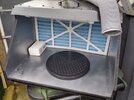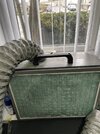Hi Barry, Jim et al,
It seems there is something very wrong here! and also some fundamental misunderstandings!
I am concerned some previous comments in this thread may mislead other hobbyists and apologise for hijacking the thread but feel that some information needs to be clarified...
The 300S-D is
NOT intended by the manufacturer to be fitted with the carbon filter.
The filtration description taken directly from their website states the following;
"The particulate (intake) filter is a three stage graduated fibre filter with a high ‘dust’ holding capacity for long life. Filtration to 5 micron particles. NB: Spray particulate sizes vary from 10 to 20 microns. The dual process of filtration and then extraction to atmosphere via flexi-duct, vastly reduces and/or eliminates operator exposure to potentially hazardous substances."
The website categorically states;
"This is an extraction unit i.e. all odours and gases are extracted to atmosphere."
This booth uses the
IFA3P filter which
does not contain carbon is also
not a HEPA Grade filter and is 'particulate' only in order to protect the internals of the spray booth, the fans blades and the duct, the motor design on the spray booth is suitable for;
- Aerosol paints
- Lacquers
- Adhesives (glue booth for Spray Mount)
- Airbrush over-spray
- Solder fume
- General solvent vapours and gases
- Grinding dusts
- General particulates
- Powders
- and more…
What I believe is causing some confusion here is the
'Standard' common label that Benchvent fit to all of their extraction units which do include ones fitted with carbon filters and more importantly ones which are designed for re-circulation such as the BV300S which is designed to re-circulate and DOES have a carbon filter, the various boxes on this table are supposed to be 'ticked' during final assembly in order to identify the Model, Voltage and what filters are fitted, it appears from the picture you have posted that these boxes have not been ticked or correctly ticked / highlighted or an X added in your case, it is very important that the 300S-D and 300S are not confused, the addition of the -D is a significant difference in design and operation.
Your unit should have the BV300S-D box ticked and then the IFA3 box ticked below, it clearly does not have the FKA3 box ticked and should not have.
The filtration description for the 300S is as follows;
"The particulate (intake) filter is a three stage graduated fibre filter with a high ‘dust’ holding capacity for long life. Filtration to 5 micron particles. NB: Spray particulate sizes vary from 10 to 20 microns. The carbon impregnated fibre filter (behind intake) assists in the reduction of solvent odours. Through the process of filtration, adsorption and dilution, operator exposure to potentially hazardous substances is vastly reduced."
The 300S also states;
"The BV300S is not recommended for continued use, such as in production applications, especially in extremely confined areas where harmful solvent vapours and fumes may accumulate."
The product data sheet goes to categorically state;
"These units are designed as predominantly ‘spray traps’ for studio/workshop cleanliness and for immediate operator protection from concentrations of airborne contaminants. They are not recommended for continual usage, i.e. production applications, particularly in confined and/or badly ventilated areas.
See extraction cabinets BV300S-D, BV200H-D and BV100H-D for total solvent odour and gas extraction, or BV660H-C or BV930H-C filtration cabinets for higher specification filtration"
This is because the BV300S DOES NOT vent to outside such as the BV300S-D, which is why it is fitted with carbon filtration....
It is VERY important to note that the 300S-D is designed to move more air than the 300S (355m3/hr compared to 325m3/hr) and has a higher Air velocity at the filter face (0.6m/sec vs 0.5m/sec, but even more importantly has a higher velocity at the hood face (0.50m/sec Vs 0.35m/sec), in basic terms the 300S-D moves more Air...
The 300S-D is designed to only use the IFA3P filter.
The 300S however can use a variety of filters and combination filters depending on the particular
re-circulating application, these include the standard FKA3 particle and impregnated carbon filter, the IF3P particle filter + CHA3 charcoal impregnated filter, above combinations + PRE45 pre-filter and also the HE495P HEPA filter + PRE45 pre-filter where it is only particulate that is being protected against.
The important point here is that by fitting a carbon filter into the 300S-D you will be reducing the air flow due to the pressure drop across the filter, not only that but in real terms it is entirely pointless, as well as expensive!! unless you wish to reduce emissions to atmosphere and are looking for Brownie points from Greta Thunberg!!
In reality it is a pointless exercise as a hobbyist considering how much solvent laden air is vented from car repair shops and industrial spray paint plants!
Fitting carbon filters to the 300S-D is detrimental to its operation and serves no purpose.
I should also point out that those who own the Benchvent will know that the OEM filters IFA3P are quite expensive but with a little study and investigation many have identified that the actual filter material used is in truth a very low quality filter material and can very easily be replaced using the same frame (existing carefully modified with the use of a craft knife and some tape) using products such as DuplexPro which is a high grade fibreglass free synthetic dual layer spray booth filtration medium. Using DuplexPro you can replace the filter for a little as £1.18 a filter and thats without any discount and at full list price!!
My apologies for the long post but I very much feel it is important that misleading information about these spray booths is not circulated and becomes 'Modelling fact'.
In respect to replacement frequency for the particulate filter on the 300S-D, without having expensive measuring equipment such as an accurate hot-wire anemometer or a Velometer then it is basically down to a matter of visible contamination, this will entirely be based on usage frequency and also very much the types of paint being used.
Heavy primers which have a high pigment particle size will contaminate the particulate filter far quicker than lacquer paints being thinned 50/50 or more which will inherently have a very much smaller pigment particle size (in general).
In simple terms a fixed replacement frequency cannot be stated for this type of particle filter and is entirely subject to usage, it will not degrade just based on time.
Just to be clear on this, I do not work for Widespread Solutions Ltd (Graphic Air / Benchvent) but I do have some extensive experience in this area, I am a retired Engineer who worked in industry for over 36 years during which time I was not only a design engineer for LEV (Local Exhaust Ventilation) systems as well a paint spray systems I was also the UK National Maintenance Manager for a large international Gases company and which used extensive extraction and ventilation systems for not only large paint spray systems including those using isocyanates (2 Packs / base + hardeners) but also for Toxic gases in fume cabinets, pharmaceutical biological & chemical fume cabinets and systems subject to validation under GAMP 5 & MHRA approval (I was fully trained and a member of The ISPE) as well as HGV vehicle exhaust extraction systems.
During this time I spent weeks if not months dealing with the complexities of extraction systems as well as many filtration methods and mediums including all types of particulate filters including the design, operation and maintenance of ISO Class 5 Cleanrooms. This included dealing with sales persons from companies who would promise you the world then unfortunately fail to deliver, luckily the requirements to fully pass validation protocols meant that if their equipment did not perform they did not get the contract or if (unlikely) it had been installed they did not get paid and were contracted to remove it and recompense fully!
Hope my information helps..











